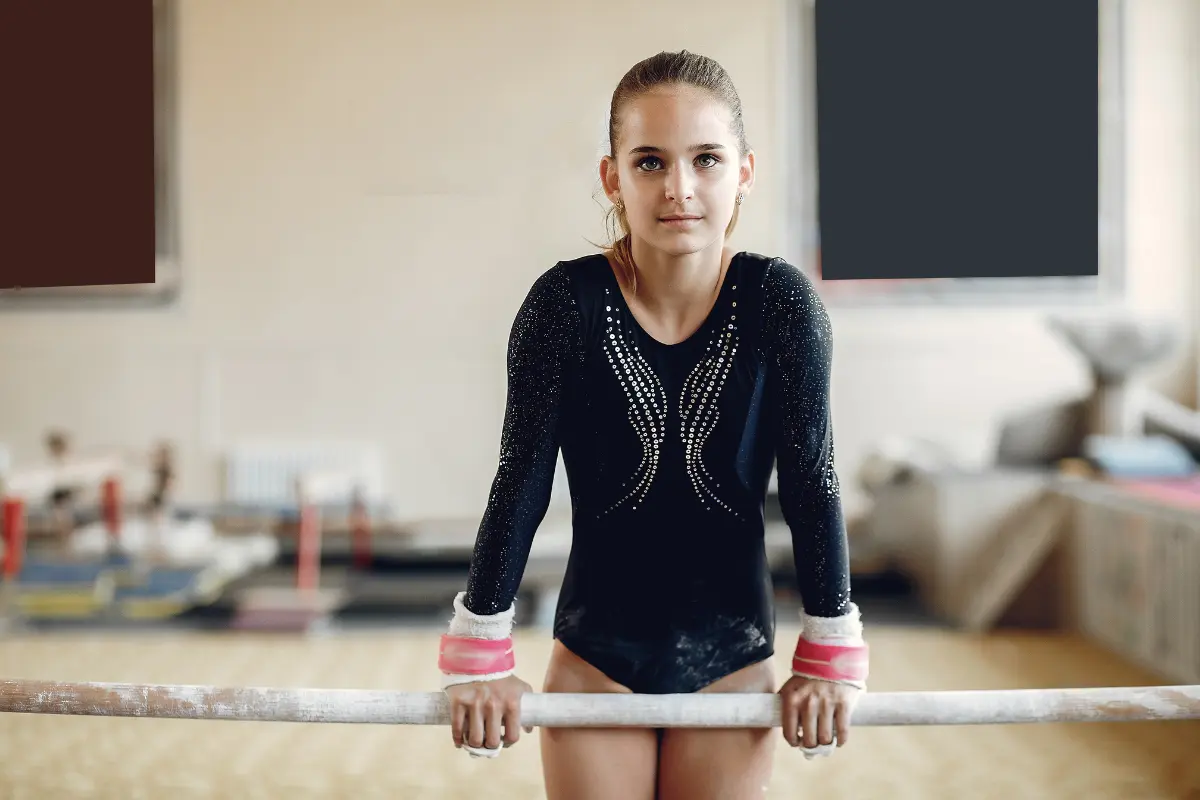When you picture a gymnast, you might imagine someone small, compact, and incredibly strong. Many Olympic athletes in the sport fit this image, leading people to believe there’s a specific height requirement to compete. But is that actually true?
Let’s clear up the confusion, separate myth from fact, and explain how height really fits into the gymnastics world.
How Tall Do You Have to Be to Do Gymnastics?
In competitive gymnastics, whether in the USA Gymnastics Development Program (DP), Xcel, or international competitions under the FIG Code of Points, there is no rule that sets a minimum or maximum height for athletes.
Eligibility is based on age, skill level, and performance, not stature. A gymnast could be 4’8” or 5’9” and still compete at a high level if they have the strength, flexibility, and technique required for their level.
Key Point: Height alone doesn’t determine eligibility. Gymnastics welcomes athletes of all shapes and sizes.
Why the Height Myth Exists
The misconception likely comes from what we see at the elite level. Many top gymnasts, especially women, are shorter than average. This isn’t because taller athletes are banned—it’s because certain body mechanics can make some skills easier:
- Faster Rotations – Shorter limbs can help gymnasts spin and twist more quickly.
- Lower Center of Gravity – This can make balance adjustments faster and more stable, especially on the beam.
- Strength-to-Weight Ratio – A compact build can make explosive power more efficient for tumbling, vault, and swing elements.
These are performance advantages, not entry requirements—and taller gymnasts have their own strengths to bring to the sport.
Height in Women’s vs. Men’s Gymnastics
At the elite level, height trends differ slightly between men and women because of the demands of their events.
- Women’s Artistic Gymnastics (WAG): Most top competitors are between 4’8” and 5’3” (142–160 cm). This range often supports quick rotations, fast bar transitions, and a strong power-to-weight ratio.
- Men’s Artistic Gymnastics (MAG): Many elite male gymnasts fall between 5’4” and 5’7” (162–170 cm), balancing upper-body strength for rings and bars with agility for floor and vault.
These are averages, not rules. Athletes like Svetlana Khorkina (5’5”), Gabby Douglas (5’3”), and Max Whitlock (5’7”) show that success isn’t limited to one body type.
Why Height Is Not a Limit in Gymnastics
In gymnastics, height may shape how an athlete approaches certain skills, but it does not determine whether they can succeed. The sport’s history is filled with champions across a wide range of heights, proving that technique, power, and creativity matter far more than inches or centimeters.
1. Technique Can Be Adapted
Every skill in gymnastics—from a back handspring on beam to a Tkachev on bars—can be tailored to match an athlete’s body type.
- Taller gymnasts may use slightly different takeoff angles, grip widths, or step patterns.
- Shorter gymnasts may focus on maximizing amplitude and presence to match visual impact.
With the right coaching adjustments, height becomes just one variable in the equation, not a barrier.
2. Strength and Power Outweigh Stature
A gymnast’s ability to generate force and control their body in the air matters more than how tall they are. Strength training, explosive sprint work, and plyometrics can give both tall and short athletes the tools they need to perform high-difficulty elements.
3. Apparatus Settings Can Be Customized
Bars can be adjusted for width, mats can be stacked or spaced for vault approaches, and choreography can be arranged to suit a gymnast’s lines. Elite coaches regularly make these adjustments for their athletes, regardless of height.
4. Many Styles Can Win
Gymnastics judging values execution and artistry just as much as difficulty. What judges actually favor is:
- Clean form: Straight legs, pointed toes, tight body shapes.
- Controlled landings: Sticking dismounts without steps or hops.
- Artistry that matches the gymnast’s build: A taller gymnast using their reach for beautiful split leaps; a shorter gymnast using explosive speed for eye-catching tumbling.
Different styles can earn the same high scores if performed with quality and confidence.
5. Real Champions Come in All Heights
While many elite gymnasts are shorter, plenty of taller athletes have reached the highest levels, proving that height is not a barrier to success.
- Svetlana Khorkina (5’5” / 165 cm) – A two-time Olympic uneven bars champion from Russia, known for creating innovative skills that suited her longer frame.
- Nina Derwael (5’6” / 167 cm) – Belgium’s Olympic and World uneven bars champion, famous for her fluid swing and elegant style.
- Kyla Ross (5’7” / 170 cm) – U.S. Olympic team gold medalist and five-time NCAA champion, celebrated for her clean execution and artistry.
- Epke Zonderland (5’10” / 178 cm) – Dutch Olympic high bar champion, renowned for his massive release moves and unique combinations.
- Max Whitlock (5’7” / 170 cm) – British Olympic champion on pommel horse and floor, balancing strength, flexibility, and precision.
These gymnasts didn’t fit the “typical” height mold, but they mastered techniques, adapted their training, and used their body type to their advantage.
Conclusion
There’s no “perfect” height for gymnastics. Shorter gymnasts may rotate faster and balance more easily, while taller gymnasts can stand out with long lines and powerful swings. Success comes from skill, strength, and smart training—not how tall you are. Whatever your height, gymnastics has space for your style to shine.












